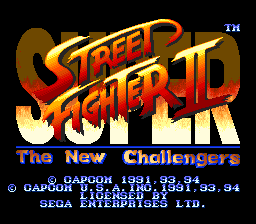Difference between revisions of "Super Street Fighter II: The New Challengers"
From Sega Retro
| Line 56: | Line 56: | ||
[[Category:Mega Drive Action Games]] | [[Category:Mega Drive Action Games]] | ||
[[Category:Sega Channel Games]] | [[Category:Sega Channel Games]] | ||
| + | [[Category:TecToy Mega Net Games]] | ||
Revision as of 10:08, 7 March 2011
| Super Street Fighter II: The New Challengers |
|---|
| System(s): Sega Mega Drive |
| Publisher: Capcom |
| Developer: Capcom |
| Genre: Action |
| Number of players: 1-2 |
Super Street Fighter II: The New Challengers (スーパーストリートファイターII THE NEW CHALLENGERS) is one of many updates to Street Fighter II, and was originally released in arcades in 1993. It was brought to the Sega Mega Drive in the following year.
Unlike previous entries in the series Super Street Fighter II ran on the more powerful Capcom CPS-2 hardware (as opposed to the CPS-1 which previous entries in the series used), which meant that although the core gameplay was the same, many refinements to the graphics and audio could be made. It also introduces four new characters; T. Hawk, Cammy, Fei-Long and Dee Jay. The game would be followed up by yet another update (which eventually made its way to the Sega Dreamcast) - Super Street Fighter II Turbo.
Super Street Fighter II was the second Street Fighter II game to be released for the Sega Mega Drive, and improves many of the features last seen in Street Fighter II': Special Champion Edition. It uses a different sound driver and the majority of graphics have been re-drawn and improved. It also re-introduces missing elements in Special Champion Edition, such as the announcer's voice. However, this came at a cost — the game ROM was 5MB, while the Mega Drive can only safely access 4MB (you can theoretically go up to 10MB but the Sega CD and 32X will clobber you). Capcom created a special mapper unit to get around this problem; this is the only officially licensed game on the Mega Drive to use a bank switching mapper (rather than an SRAM mapper). The custom hardware and larger ROM, however, drove the game's price quite high (the only other licensed Mega Drive games costing more than ¥10,000 were Koei's various titles — but those were deliberately sold at those prices).



